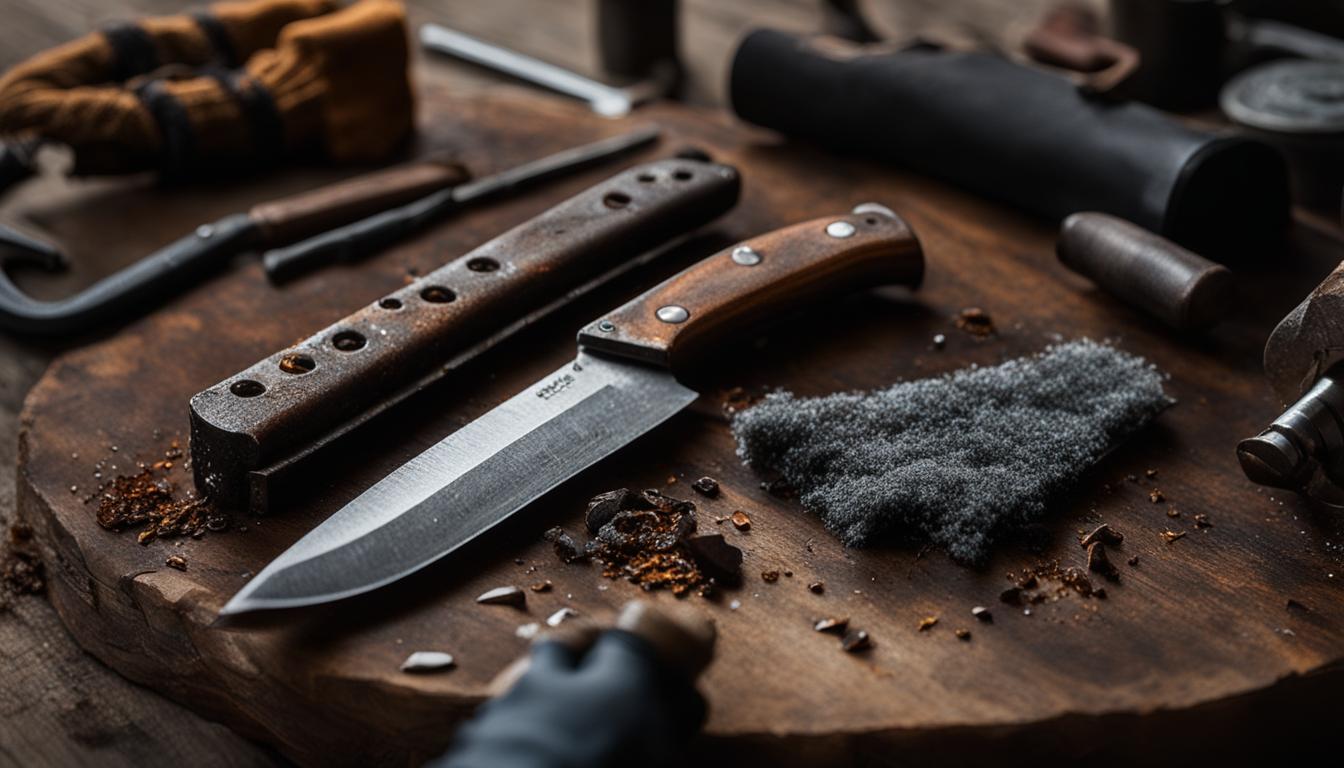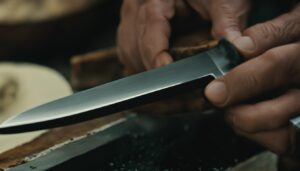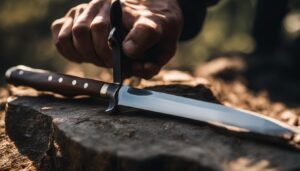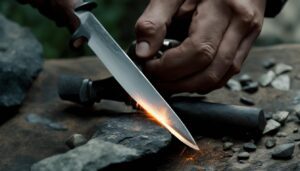Rust can be a common issue for hunting knives, but with the right maintenance and care, you can easily remove rust and keep your blade sharp. Whether you have a drop point, clip point, gut hook, Bowie, or skinning knife, understanding the type of knife and the correct sharpening techniques is crucial. There are various sharpening tools available, such as sharpening stones, honing rods, electric sharpeners, pull-through sharpeners, and guided sharpening systems, each with its advantages and disadvantages. Before sharpening your hunting knife, it’s important to prepare the blade by cleaning it and checking for any nicks or chips. Determining the correct sharpening angle and choosing the appropriate sharpening method are also essential for optimal results.
Key Takeaways:
- Regular maintenance and care can help remove rust and keep hunting knife blades sharp.
- Understanding the type of knife and using the correct sharpening techniques is crucial.
- There are various sharpening tools available, each with its advantages and disadvantages.
- Cleaning the blade and checking for any damage before sharpening is important.
- Determining the correct sharpening angle and method is essential for optimal results.
Types of Hunting Knives and their Sharpening Techniques
When it comes to hunting knives, there are various types that require specific sharpening techniques. Understanding the characteristics of each knife and knowing the right sharpening tools and methods can help you maintain a sharp and reliable blade. Let’s explore the different types of hunting knives and the best techniques to keep them sharp.
Drop Point Knife
A drop point knife is known for its curved edge, which makes it versatile for a range of tasks. When sharpening a drop point knife, it’s important to maintain a consistent angle along the curved edge. Using a sharpening stone or honing rod with a rounded edge can help you achieve optimal results.
Clip Point Knife
A clip point knife features a straight edge, making it easier to sharpen compared to other knife types. Using a straight-edged sharpening stone or honing rod can help you maintain a consistent angle and achieve a sharp blade.
Gut Hook Knife
Sharpening a gut hook knife requires special attention. The hook’s edge should be sharpened separately from the rest of the blade. Using a small, rounded sharpening stone or rod can help you sharpen the hook effectively while maintaining the integrity of the blade.
Bowie Knife
The Bowie knife is characterized by its length and curve, which requires a longer sharpening stone or honing rod. When sharpening a Bowie knife, it’s important to maintain a consistent angle along the length of the blade to ensure an even sharpening.
Skinning Knife
Skinning knives often have narrow blades that are easier to sharpen but may require more frequent maintenance due to their thinness and flexibility. Using a sharpening stone or honing rod suitable for narrow blades can help you achieve a sharp edge and preserve the knife’s performance.
Remember, each knife type has its own sharpening requirements. By using the appropriate sharpening tools and techniques, you can ensure that your hunting knives remain sharp, durable, and ready for any outdoor adventure.
Different Types of Sharpening Tools for Hunting Knives
When it comes to sharpening your hunting knife, having the right tools is essential. There are various options available, each with its advantages and disadvantages. Let’s explore the different types of sharpening tools commonly used for hunting knives.
Sharpening Stone
A sharpening stone, also known as a whetstone, is a versatile and traditional tool used for sharpening hunting knives. Available in natural or synthetic materials, sharpening stones offer a range of grits to accommodate different sharpening needs. They require water or oil for lubrication, ensuring proper sharpening and maintaining the blade’s integrity. Sharpening stones provide precise control and allow you to hone the edge of your hunting knife with accuracy.
Honing Rod
A honing rod, made of steel or ceramic, is designed to straighten and refine the edge of a blade, rather than sharpen it. It is a useful tool for regular maintenance and touch-ups between sharpening sessions. By using a honing rod correctly, you can enhance the cutting performance of your hunting knife. It is important to note that honing rods do not remove material from the blade but rather realign the microscopic teeth along the edge.
Electric Sharpener
Electric sharpeners are popular for their speed and efficiency. They typically feature abrasive belts or discs that rapidly sharpen the blade. Electric sharpeners are easy to use, making them a convenient choice for hunters who want quick results. However, it is crucial to handle the knife correctly to prevent removing excessive amounts of material, which can shorten the blade’s lifespan.
Pull-Through Sharpener
A pull-through sharpener is a compact and user-friendly tool that offers convenience and ease of use. It consists of built-in sharpening slots with preset angles, making it suitable for beginners or those who desire a simple sharpening process. While pull-through sharpeners may lack the precision of other tools, they are an excellent option for maintaining a moderate level of sharpness on hunting knives.
Guided Sharpening System
A guided sharpening system is ideal for individuals who prioritize precision and consistency in their sharpening routine. It features a sharpening stone or rod mounted on a guide, allowing you to maintain a consistent angle throughout the sharpening process. This tool is particularly helpful for beginners, as it helps achieve optimal results without requiring extensive experience or skill.
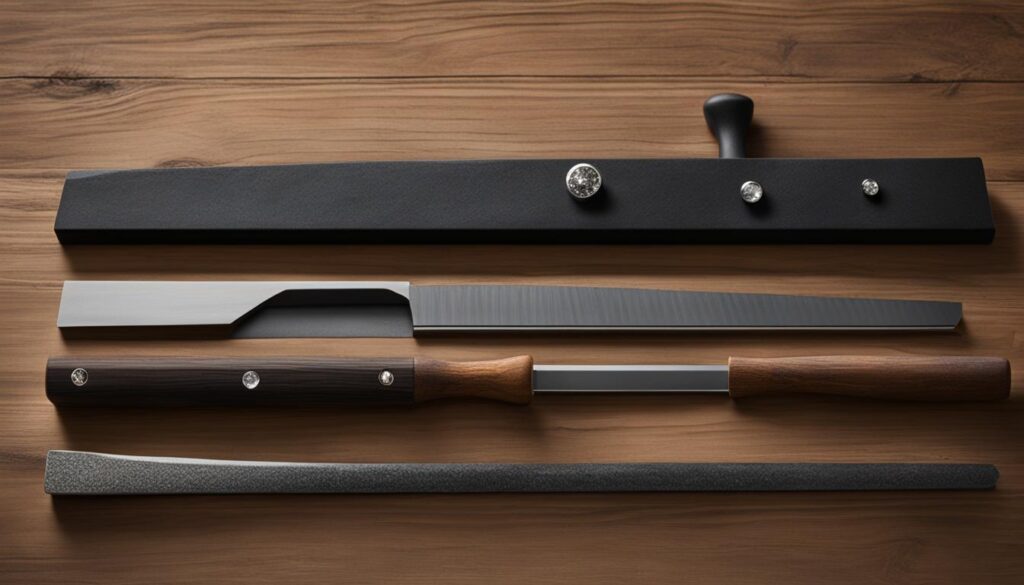
Choosing the right sharpening tool for your hunting knife depends on your preferences, skill level, and desired sharpening outcome. It is essential to select a tool that aligns with your needs and enables you to achieve a sharp and durable blade.
Tips for Sharpening and Maintaining Your Hunting Knife
When it comes to sharpening and maintaining your hunting knife, a few key steps can make all the difference. Start by cleaning the blade with a damp microfiber cloth to remove any dirt, debris, or residue. This ensures a clean surface for sharpening and prevents any unwanted buildup.
Next, it’s important to check the blade for any nicks or chips. These imperfections can affect the performance of your knife and should be addressed before sharpening. Smooth out any rough edges with a file, ensuring a smooth and even blade surface.
Determining the correct sharpening angle is crucial for optimal results. Consult the manufacturer’s recommendations or use a sharpening guide to find the appropriate angle for your hunting knife. This ensures that you maintain the blade’s original shape and edge integrity.
Now it’s time to choose the right sharpening method for your skill level and knife type. Beginners may find a guided sharpening system or an electric sharpener to be more user-friendly, while experienced users may prefer a sharpening stone or honing rod for more control. Whatever method you choose, remember to maintain a consistent angle and follow the instructions carefully.
Regular maintenance is key to keeping your hunting knife in top condition. Clean the blade after each use, checking for any signs of wear or damage. By following these tips for sharpening and maintenance, you’ll ensure that your hunting knife stays sharp and reliable for years to come.
FAQ
How can I remove rust from my hunting knife?
To remove rust from your hunting knife, you can use a rust remover, such as vinegar or lemon juice, and scrub the affected area gently with a cloth or brush. Make sure to thoroughly dry the blade after removing the rust to prevent further corrosion.
What is the best sharpening tool for a drop point knife?
For a drop point knife, a sharpening stone or honing rod with a rounded edge is ideal. This helps maintain a consistent angle along the curved edge of the blade for optimal sharpening.
How should I sharpen a gut hook knife?
When sharpening a gut hook knife, it’s important to sharpen the hook edge separately from the rest of the blade. Use a sharpening stone or rod that can fit into the hook’s curve and maintain a consistent angle.
Are electric sharpeners suitable for all types of hunting knives?
Electric sharpeners can be used for most types of hunting knives, but they should be used correctly to avoid removing too much material. It’s important to follow the manufacturer’s instructions and use gentle pressure to prevent overheating and damaging the blade.
How often should I sharpen my skinning knife?
Skinning knives with narrow and flexible blades may require more frequent sharpening due to their thinness. It’s recommended to sharpen your skinning knife after every few uses to maintain its sharpness and performance.
What should I do before sharpening my hunting knife?
Before sharpening your hunting knife, it’s important to clean the blade using a damp cloth to remove any dirt or debris. Additionally, check for any nicks or chips on the blade and smooth them out with a file before proceeding with sharpening.
How do I determine the correct sharpening angle for my hunting knife?
You can refer to the manufacturer’s recommendations or use a sharpening guide to determine the correct sharpening angle for your hunting knife. Consistency is key, so make sure to maintain the same angle throughout the sharpening process.
What is the best sharpening method for beginners?
If you’re a beginner, it’s recommended to start with a guided sharpening system or an electric sharpener. These tools provide more stability and guidance, making it easier to achieve a consistent and sharp edge on your hunting knife.
